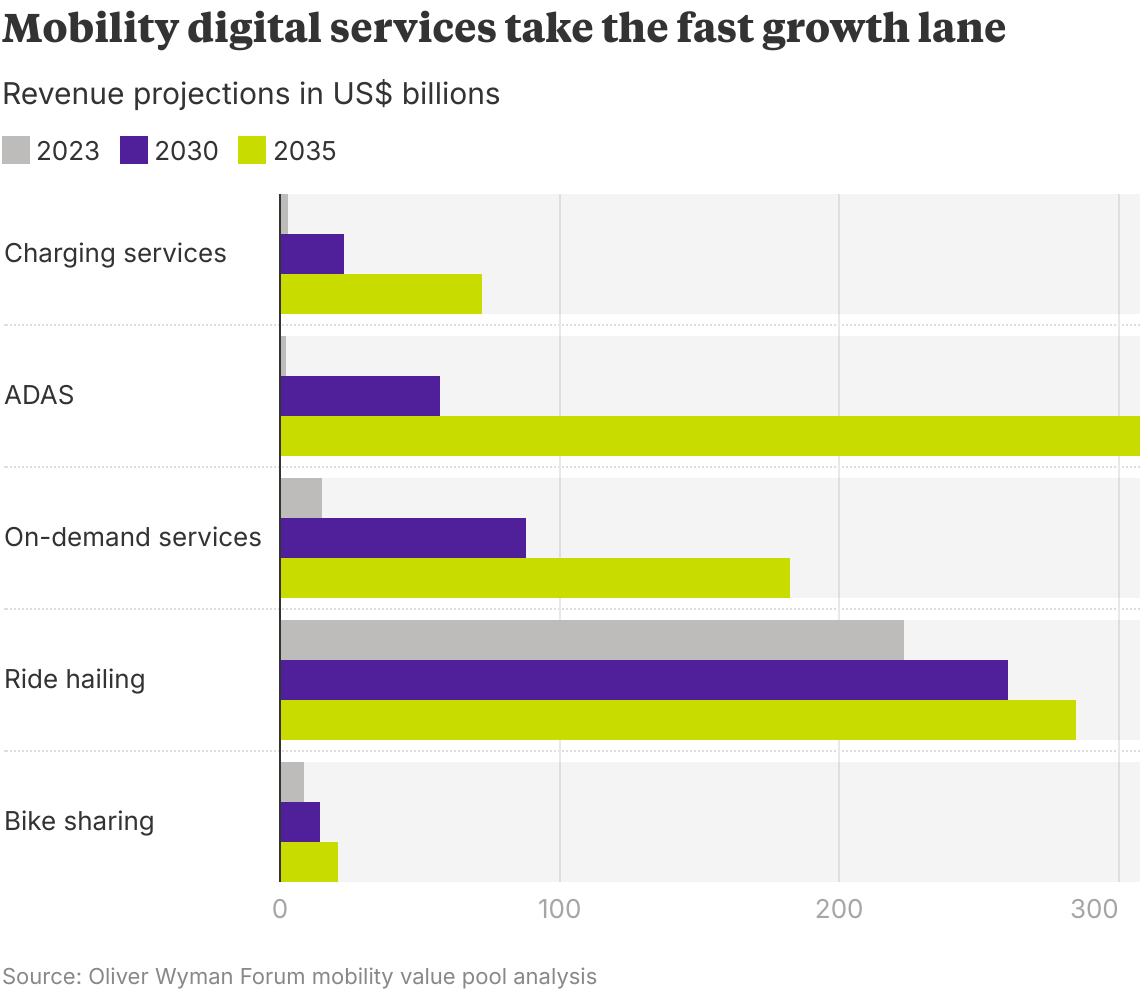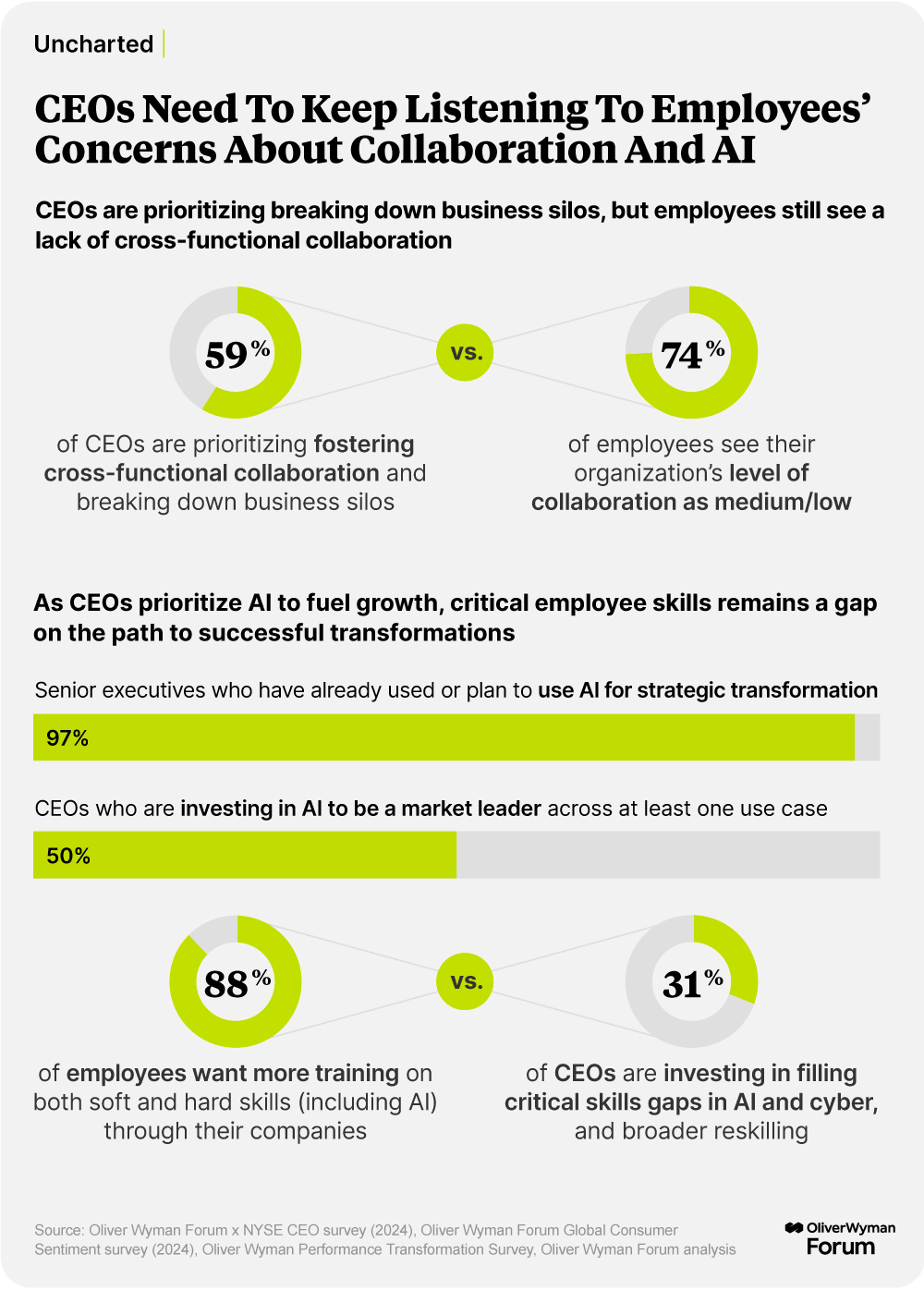Pull over, ride-hailing drivers and bike-sharing riders. The new leaders in the race to define modern mobility are digital services aimed at car owners, including driver-assistance systems and electric vehicle (EV) charging services.
Next-generation technology is intersecting with regulatory shifts and industry consolidation to drive rapid growth in the mobility services industry, with revenues projected to nearly triple to more than $1.1 trillion in 2035, according to a new report from the Oliver Wyman Forum.
Ride-hailing is the largest single market, worth $223 billion last year, but it’s now a mature industry likely to grow in the single digits over the next decade. By contrast, the rise of EVs and the technological push toward autonomous driving will propel rapid growth in digital services aimed at automobile owners. These services, which also include smart parking and car infotainment systems, are projected to grow by 25% a year through 2035.
The changing mobility landscape has implications for business, cities, and the climate. Greener modes of travel, like EVs and cycling, can help reduce greenhouse gas emissions. Advanced driver-assistance systems (ADAS) that help drivers stay in their lanes and warn of potential collisions can reduce accident rates and keep drivers, passengers, and pedestrians and cyclists safer, while the spread of smart parking could save travelers time and money.
Public-private partnerships will be increasingly important in ushering in this future because the private sector can contribute data and cutting-edge technology for cities to adopt the latest mobility innovations on their streets.
Digital services are poised for takeoff
The market for driver-assistance technology is small but about to get very big, reflecting rapid improvements in the technology’s capabilities, consumer demand, and the willingness of governments to mandate its adoption for safety purposes.

Most ADAS-related revenue today comes from so-called Level 2 services, ranging from cruise control and lane assist to hands-free services that can help steer, accelerate, and decelerate vehicles but require the driver to pay attention at all times. The European Commission mandated that all new vehicles must have ADAS features like intelligent speed assistance and drowsiness warnings as of July 2024, while the United States is requiring emergency braking to be standard on all new passenger vehicles by September 2029.
Level 3 technology takes a bigger step toward automation, enabling cars to automatically pass a slow-moving vehicle, for example, and allowing drivers to take their attention off the road. Such services are available only in select markets for now, but governments have been testing them. China in June 2024 approved nine automakers to test vehicles with Level 3 ADAS technology on public roads while Japan in 2023 began allowing self-driving vehicles on public roads under certain conditions. Nearly half of consumers say they would definitely or probably use autonomous private cars and 43% are willing to pay a premium for them, according to a June 2024 Oliver Wyman Forum survey.
All of this suggests a steep adoption curve that will boost ADAS revenue by 54% a year, to $307 billion in 2035 from $1.7 billion last year, according to the Oliver Wyman Forum report.
Full autonomous driving could fuel even stronger growth. Two US cities — San Francisco and Phoenix — already allow autonomous robo-taxis and the UK government in May passed a law allowing self-driving vehicles on British roads by 2026. But widespread adoption will require the industry to align on safety standards to build consumer trust and governments to adopt regulations or enact legislation to settle who is liable for accidents — the software provider, the car manufacturer or seller/lessor, or the vehicle owner.
In the meantime, other connected services that are less dependent on regulatory approvals promise to grow at a rapid pace. In-vehicle digital services, which range from safety features to advanced infotainment systems and Wi-Fi packages, are projected to grow to nearly $182 billion in 2035 from $14.9 billion in 2023.
In EV charging, meanwhile, companies in the energy, manufacturing, and heavy industrial sectors are investing in service providers, and larger players are buying up smaller competitors and integrating companies across the supply chain. This consolidation will drive increasing uniformity in charging services and help boost charging revenues to $72 billion in 2035 from $2.6 billion last year.
The future doesn’t belong solely to the automobile, even if it is the most lucrative vehicle for many digital services. Oliver Wyman Forum analysis anticipates that personal vehicles will account for just under half of Europe’s transport modal mix by 2035, down from 66% in 2023, while the share of sustainable options like public transport, micromobility, and shared mobility is expected to rise.

In Asia, meanwhile, a growing middle class will drive mobility services growth of 11% a year, the fastest of any region. With populations concentrated in dense cities with a lack of parking and high regulatory barriers to car ownership, Asia offers significant opportunity for growth in ride-hailing as well as car-sharing and subscription services. Asia’s early lead in EV adoption and affordability creates significant potential for growth in charging services.
Cities, meanwhile, can strike the right balance in lowering carbon footprints and managing traffic flow by collaborating with the private sector in areas like EV charging and integrating shared mobility modes with public transit systems. “We have a small window to bend the emissions curve,” Micah Kotch, a partner at energy transition specialist Blackhorn Ventures, told a recent Oliver Wyman Forum roundtable on sustainable mobility.
 Member of Parliament, Tanzania
Member of Parliament, Tanzania
“Success would be the number of women who come forward in the elections. When you vie and lose, that’s a learning process. Winning? That’s the next step.”
Every month, we highlight a key piece of data drawn from three years’ worth of consumer research.


